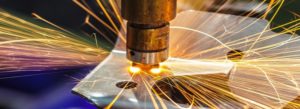February 23, 2016

The research done in FIMECC MANU program revealed that 3D-printed metal objects can be welded with good quality. The result ensures the fully utilisation of 3D-printing technology in production offering totally new opportunities and significant savings.
The potential market for 3D-printing is estimated to be 4 billion euros. In industrial applications 3D-printing is mainly used for rapid prototyping. However, the utilization of 3D-printing technologies in production is also increasing with 30 % annual growth.
3D-printing offers several advantages for production. The advantages of 3D-printing are clear when talking about complex products and objects consisting several different parts and requiring lots of machining. ”In 3D-printing complex objects can be made as easily as simple ones. In 3D-printing the complexity comes for free”, states Professor Jouni Partanen from Aalto University.In MANU program, for example, gluing head used in Raute’s machinery was produced with 3D-printing technology. The production costs of this complex part requiring lots of machining was reduced to approximately 10 % from original machined part.
In addition 3D-priting offers new opportunities for product and business innovations. With 3D-printing technology products can be re-designed enabling optimised product performance, increased material efficiency and significantly lighter structures. 3D-printing also enables location independent production reducing transportation and offering totally new approach to spare part business for machine and equipment manufacturers.
In order to fully deploy the advantages of 3D-printing technology in industrial applications welding solutions are needed. The weldability of 3D-printed metal objects and the save parameter values required for welding were researched in FIMECC MANU program among the first in the world. The results showed that 3D-printed metal object can be welded with good quality and with weld properties comparable to other base materials.
The results enables the expansion of the utilization of 3D-printed objects in industrial applications. The ability to weld 3D-printed objects also ensures that the fully potential of the technology can be deployed in manufacturing.
“3D-printing enables designs impossible to produce with conventional manufacturing, the potential is huge, but probably the design will evolve into ever more complicated shapes. In this stage, there are various design rules which in practice restrict the shape of 3D-printed parts, and not all designs are possible. The maximum dimensions of 3D printing machines is also often too small to produce larger components. In addition usually 3D-printed object are part of different assemblies and the printed parts have to be joined with other components fulfilling other functions and often this should be done by welding”, tells Professor Antti Salminen from Lappeenranta University of Technology.
By welding 3D-printed components with other components or 3D-printed parts together it is possible to overcome the restrictions of the 3D-printing. Welding enables the production of large parts and designs that are not possible to produce. In addition weldability ensures that 3D-printed objects can be used in assemblies in which the different parts of product must be welded together to ensure structural integrity. Weldability offers competitive advantage as the gains of 3D-printing be fully deployed in production and manufacturing setting. Without the weldability the fully utilisation of 3D-printing technology in production would be impossible.
Moreover, the ability the weld 3D-printed objects opens totally new solutions to utilize 3D-printing in industrial applications. The trend to individualisation requires flexibility from production. 3D-printing is highly flexible production technology enabling individualised production and design changes. By welding individualized 3D-printed objects with other components rapid customization can be achieved efficiently.
